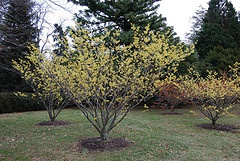Witch Hazel
Witch Hazel Hamamelis virginiana ‘Common Witch Hazel’
Hardiness Zones: Zones 3-8
Light Requirements: Full Sun to Part Shade
Water Requirements: Moist
Mature Height: 15-30 feet
Mature Spread: 15-25 feet
Shape: Somewhat rounded vase shaped
Growth Rate: Medium
Soil Preference: Moist, cool, well drained acidic soil but tolerates a variety of conditions except clay
Foliage: Oval leaves open reddish bronze, mature to green, yellow in fall
Blooms: Spidery yellow flowers are fragrant
Fruit: Shiny black seeds pop from previous year’s blooms.
Disease and Insects: Ignored by most pests
Fertilize: Apply a well balanced liquid fertilizer monthly in the growing season.
Pruning: Prune after blooming. May sucker, remove at the base to maintain neat form.
This large well rounded, vase shaped shrub, also prunes well to a tree form. It is multi stemmed and form is open and attractive. Witch Hazel grows at a moderate rate, increasing 13-24 inches per year. Spidery yellow flowers bloom all along the branches and have a sweet and spicy fragrance, blooming in October and November after foliage begins to drop. The shrub may still be in bloom after snow is on the ground.
Witch Hazel foliage is quite lovely all year. The leaves open reddish bronze and mature to bright green, finally turning yellow and yellow orange in fall. Witch Hazel prefers a moist, cool acidic soil. Excellent for very late autumn interest and in open, natural areas. Reaches 15 feet high and wide, has been known to reach 20 -25 feet high in good conditions. Plant in early spring or late fall, with afternoon shade in hotter regions. Add compost to the soil for rich loamy soil.
Although there are many cultivars of Witch Hazel, most garden centers will carry simply the common variety. Any variety looks spectacular against a dark backdrop of evergreens or deep colored structures. Chinese Witch Hazel crossed with Japanese Witch Hazel has produced hybrids with outstanding bloom colors or orange, pink, red, purple and of course amazing shades of yellow. Look for Hamamelis x intermedia for these colorful hybrids, but they typically will be less hardy, zones 5-8.


